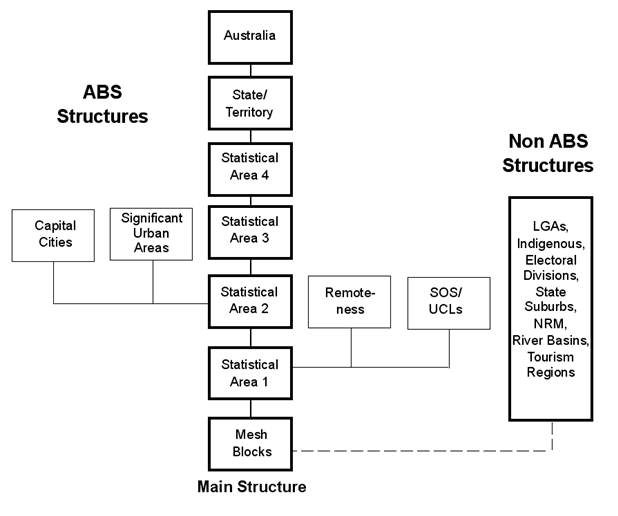 THE NEW AUSTRALIAN STATISTICAL GEOGRAPHY STANDARD
THE NEW AUSTRALIAN STATISTICAL GEOGRAPHY STANDARD
In 2011 the ABS will replace the current Australian Standard Geographical Classification (ASGC) with the new Australian Statistical Geography Standard (ASGS). The ASGS will be used for the 2011 Census of Population and Housing. The current ASGC regions such as Census Collection Districts (CCDs), Statistical Local Areas (SLAs) and Statistical Divisions (SDs) will disappear to be replaced by the new Statistical Areas Levels 1 to 4.
Regions of the ASGS
The ASGS brings all the regions used by the ABS to output data under the one umbrella. They are divided into two broad categories:
1. ABS structures, those regions which are defined and maintained by the ABS.
2. Non-ABS structures, those regions defined and maintained by other organisations, but for which the ABS supplies data.
The ABS structures is a hierarchy of regions developed for the release of particular ABS statistics.
Mesh blocks are the smallest area geographical region. There are approximately 340,000 covering the whole of Australia. They broadly identify land use such as: residential, commercial, agriculture and parks etc. Residential and agricultural mesh blocks usually contain 30 to 60 households. Mesh blocks are the building block for all the larger regions of the ASGS. Only limited Census data, total population and dwelling counts will be released at the mesh block level.
Statistical Area Level 1s (SA1s) will be the smallest region for which a wide range of Census data will be released. They will have an average population of about 400, somewhat smaller than the current CCDs. They will be built from whole mesh blocks and there will be approximately 60,000 covering the whole of Australia.
Statistical Area Level 2s (SA2s) will have an average population of about 10,000, with a minimum population of 3,000 and a maximum of 25,000. The SA2s are the key regions of the ASGS, because they are the regions for which the majority of ABS sub-state intercensal data, for example Estimated Resident Population and Health and Vital Statistics, will be released. There will be about 2,300 SA2s, built from whole SA1s.
Statistical Area Level 3s (SA3s) are a medium sized region with a population of 30,000 to 130,000. They represent the functional areas of regional cities and large urban transport and service hubs. They will be built from whole SA2s.
Statistical Area Level 4s (SA4s) will be used for the release of Labour Force Statistics and will be designed specifically as a geographical region suitable for their release. They will in turn be built from whole SA3s.
Urban Centres/Localities, Section of State and Remoteness Areas will be broadly comparable to previous Censuses.
Capital Cities and Significant Urban Areas define the major cities and towns of Australia with a population over 10,000 people. They will contain the urban area itself and any likely growth in the next 15 years, plus any immediately associated semi-rural development. The ASGS Capital City definition will be very similar to the current Capital City Statistical Division.
Non-ABS structures will be approximated or built directly from mesh blocks or SA1s. The Non-ABS structures include such important regions as: Local Government Areas (LGAs), postal areas, state gazetted suburbs and electoral divisions. LGAs remain part of the ASGS and the ABS will continue to support LGAs with the data it currently provides.
The diagram below summarises the overall structure of the ASGS.

The ABS will publish the ASGS manual with the boundaries, labels and codes for the SA units and Capital Cites in late 2010. The ASGS will come into effect on the 1 July 2011. The Non-ABS structures will be released at the time of the 2011 Census; this is to ensure that the Census is released on the most up to date boundaries available. Urban Centres and Localities, Section of State, Remoteness and Significant Urban Areas will be released after the 2011 Census as they require an analysis of Census data to be developed. Data on SLAs will still be available for the 2011 Census, but for 2012 and beyond ABS data will only be released on the ASGS regions. The regions defined in the ABS structures will not change until the next Census in 2016, although the Non-ABS structures will be updated annually.
Contacts
If you have any questions regarding the ASGS please email
geography@abs.gov.au.
 Print Page
Print Page